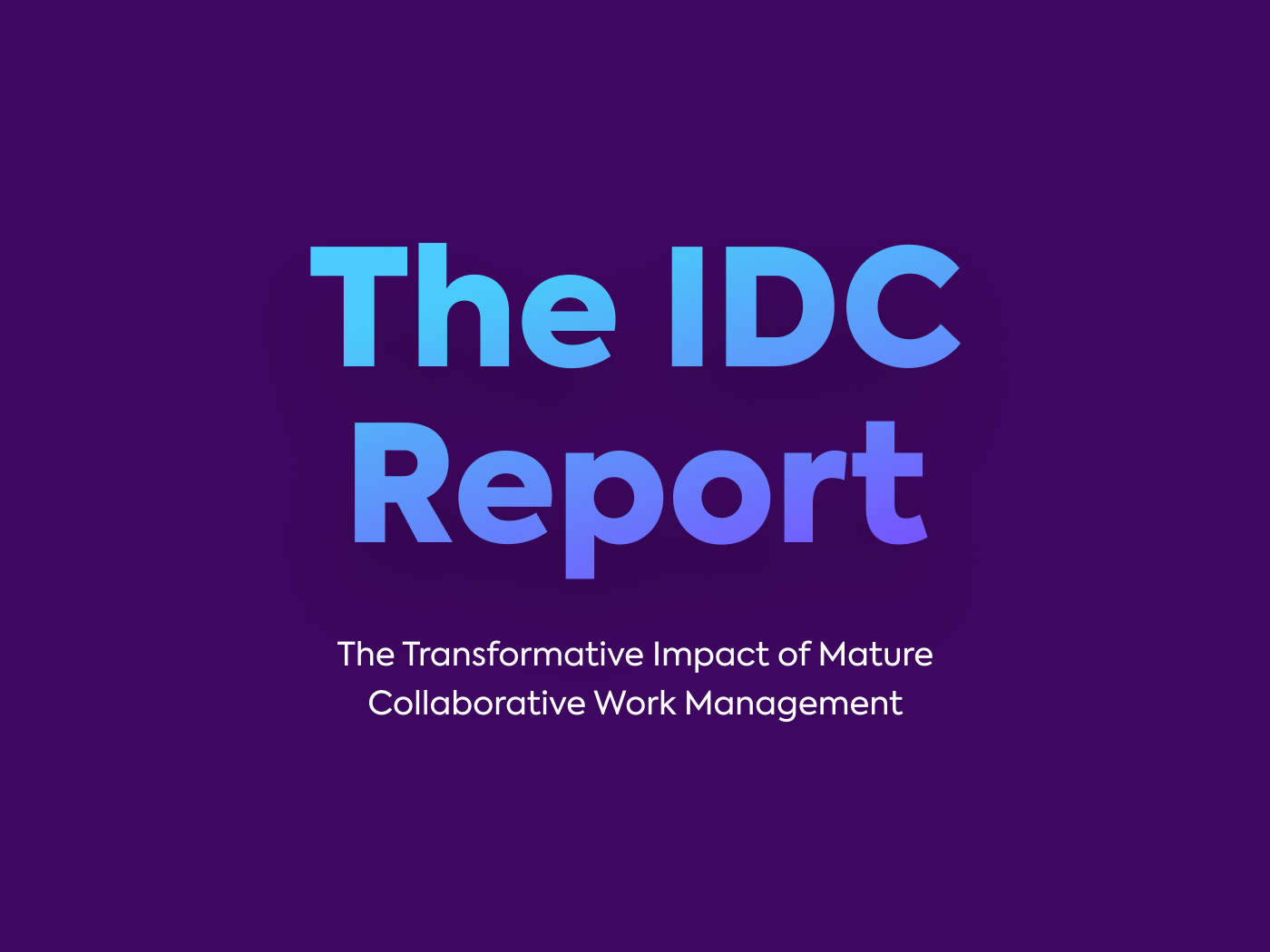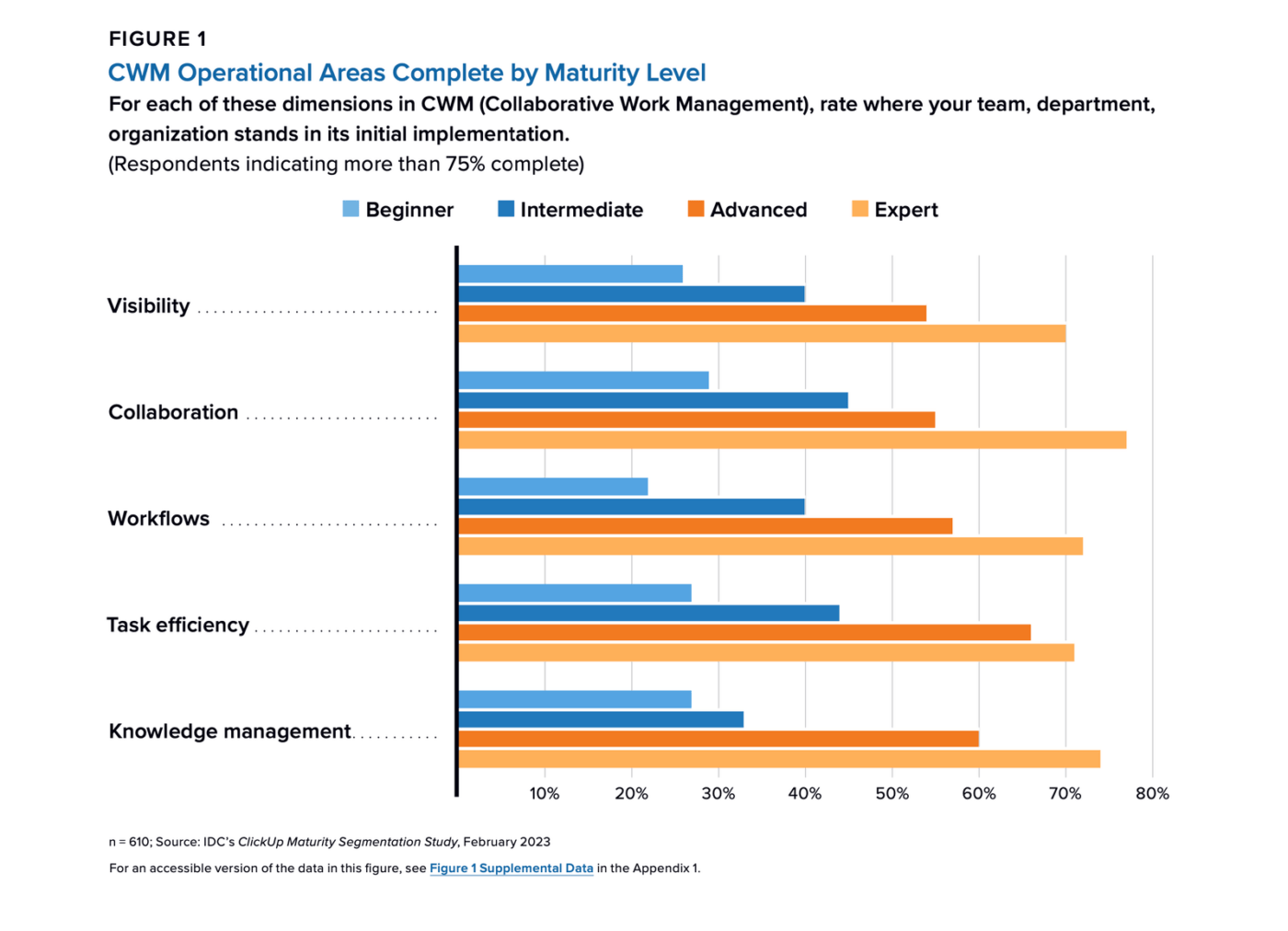

We’re constantly faced with the challenge of doing more with less. Budgets are shrinking, teams are smaller, and goals still need to be achieved.
So how do you determine which opportunities are worth pursuing? And why do some organizations excel in productivity and cost-efficiency while others struggle?
We turned to the International Data Corporation (IDC), renowned experts with over 50 years of experience, to understand what sets successful companies apart. With extensive research involving 600+ global businesses and leaders, we’ve uncovered valuable insights into their challenges, successes, and areas for improvement.
Combined with IDC’s expertise, we have created the Collaborative Work Management (CWM) Maturity Model—a powerful resource for organizations striving to enhance their results through effective teamwork.
What is the CWM Maturity Model?
To better understand the CWM Maturity Model, let’s cover the fundamentals.
What is collaborative work management?
Collaborative work management (CWM) brings teams together to deliver better results. It relies on technology to improve how work is managed, delivered, and tracked.
Coverage may vary, but in general, CWM platforms provide project management, team communication, digital collaboration, and goal-tracking solutions.
What is the CWM Maturity Model?
Whether you call it a tool, framework, or matrix, the CWM maturity model is designed to help you understand where you are today so you can create a better plan to get you where you want to go.
And we’re giving you exclusive access to IDC’s latest research so your teams can work together effectively, boost productivity, and achieve success. It consists of four distinct stages:
- Beginner
- Intermediate
- Advanced
- Expert
Each stage represents a higher level of maturity in collaborative work management. Let’s explore the four stages that will shape your team’s collaborative journey.
The 4 Stages of the CWM Maturity Model
Here’s a breakdown of each stage of the CWM Maturity Model, their challenges, and how organizations progress navigate and evolve to become highly effective.
Stage 1: Beginner
This initial stage is where productivity efforts are often led by a single team at a project level.
This pilot team is spearheading new processes and establishing best practices. It’s a critical starting point where your biggest wins are likely increased visibility and improved workflows.
But keep in mind, most of the work—and the rewards—still lie ahead.
EVERYONE STARTS SOMEWHERE
Who wants to think of themselves as a beginner? No one. But in this case, a beginner has less to do with sophistication and more to do with scope. Most organizations start here.
Stage 2: Intermediate
Building off the successes and progress of the Beginner stage, the Intermediate stage expands to include multiple teams, adapting lessons learned to a broader arena.
To support this shift, a permanent team is formed—still small at this point—that is dedicated to driving process and efficiency improvements across the organization. And they’re starting to see measurable progress across every dimension, with the most significant gains still focused on one or two areas.
THE BEST TOOLS FOR THE JOB
Bringing in the right tools for the job is a big focus for this stage. Where existing tech stacks were enough as a POC, there’s a real need for teams to adopt purpose-built tools.
Stage 3: Advanced
Teams in advanced organizations work across departments and drive greater levels of organizational discipline. The benefits and ROI become much more tangible and widespread.
The scope has expanded from teams within a department to multiple departments across a line of business. Teams become adept at handling cross-functional and cross-departmental workflows, resulting in improved operational efficiency, heightened innovation, and shorter time to market.
CROSS-DEPARTMENTAL COLLABORATION
For most businesses, this is the goal. Teams have learned how to work together across departments and lines of business. Workflows have been streamlined and the focus is more tweaking than building from scratch. There’s momentum. This level of collaboration at work and digital operations is more and more necessary in the post-pandemic workplace.
Stage 4: Expert
In the most challenging—yet rewarding stage—teams at the highest maturity level of the organization have already addressed the “low-hanging fruit” and are left with the hardest and most costly initiatives.
Why would a business attempt to reach this stage?
Typically, because there’s an external driver, such as regulatory compliance. What companies are left with are the most specialized teams with the most complex workflows. Bringing them into the company-wide workflows means reversing many of the gains they’ve won up to this point.
A TOUGH—AND SOMETIMES UNNECESSARY—FEAT FOR MANY
Now expert is a label we’d all like to attach ourselves to. But in the case of CWM maturity, few organizations will or should. Research shows that many of the admittedly impressive results that come in this stage may be more trouble than they’re worth. Companies will have to put many dollars and hours into each one.
What Determines Organizational Maturity?

The four stages above are based on five dimensions that indicate where companies are, what they should focus on, and how they can improve. Let’s dive into each one.
1. Visibility
How well can leaders and teams see the work that’s happening, determine its status, and uncover potential roadblocks?
Can you answer questions around:
- What does it take to get an update on the project status?
- How are team members spread out on a project?
- How does the work taking place connect to top-level plans?
- What can we understand about how projects are progressing: speed, roadblocks, opportunities?
2. Efficiency
How well can companies uncover and address inefficient processes?
Can you answer questions around:
- How do we measure efficiency and are systems in place to accurately do so?
- Are the necessary systems—people, processes, or technology—implemented?
- Have we identified the most significant sources of inefficiency within our organization?
3. Collaboration
How well do teams work together within and across departments?
Can you answer questions around:
- What tools and processes do we have installed to support collaboration?
- To what extent do we support distributed or asynchronous collaboration?
- Are our teams routinely working across departments and at what stages?
- What limits collaboration today and how can we address it?
- How bought in are our stakeholders?
4. Workflows
How well do established processes support and scale with cross-functional teams?
Can you answer questions around:
- Which teams or tools are excluded from our current processes and policies?
- Have we automated workflows wherever possible?
- Where do we experience the greatest amount of friction?
5. Knowledge sharing
How accessible and extensive is key project information and context to everyone involved?
Can you answer questions around:
- How much time do we spend finding necessary information?
- Have we established a culture of documentation?
- How is knowledge shared and transferred today?
- Where are we at the greatest risk of losing critical knowledge and how do we address it?
- Do we have the information and data we need to make critical business decisions?
Benefits of Applying the Learnings in the Maturity Model
Now, let’s explore the benefits of applying the Collaborative Work Management Maturity Model to your team’s collaborative journey:
Define your focus: Understand your next steps at each stage
Understanding where you are today by comparing yourself to the hundreds of businesses in IDC’s research unlocks powerful insight.
We talked above about how hard it is to understand what’s right for right now. The research outlines where businesses should focus, depending on their stage. This has several benefits.
First, it helps identify your biggest opportunities. Second, you break those opportunities down into more manageable steps. After all, taking on too much can be just as harmful as setting the wrong priorities.
Chart your path: Follow the steps of hundreds of organizations
For many organizations, this is uncharted territory.
While the lessons you learn figuring it out as you go can prove invaluable, much of it will just slow you down. In situations like that, wouldn’t it be great to have a guide? Wouldn’t it be better to have 600?
With the maturity model, you leverage the experience of 600 businesses and follow their example. Anticipate the biggest challenges and steer clear of common roadblocks.
Get an insider’s guide into the best paths to take and when to take them.
Accelerate your progress: Find the shortest distance to success
The shortest distance may not be as simple as a straight line, but understanding what investments to take on—and in what order—dramatically reduces the time required to reach your targets.
What’s more, you have the data necessary to bring your organization along. Get buy-in by showcasing results. Build credibility with a plan that outlines the top risks and strategies for avoiding them.
Keep everyone onboard with the shortest path possible. This helps you right-size your ambitions, describe common pitfalls, and highlight recommendations for moving forward. Simply put, the model makes change management a whole lot simpler.
Take Your First Step With the CWM Maturity Model
Ready to drive greater collaboration and efficiency across your teams?
Get the IDC Report today to:
- Identify where your organization stands in the CWM Maturity Model
- Learn how to navigate the common challenges of each stage of Collaborative Work Management
- Become a better, faster, more aligned workforce with a roadmap to success



